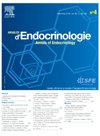Peppermint: Can it influence the clinico-biological phenotype of women with PCOS?
IF 2.9
3区 医学
Q3 ENDOCRINOLOGY & METABOLISM
引用次数: 0
Abstract
Introduction
Polycystic ovary syndrome (PCOS) is the most common endocrinopathy in women of childbearing age, affecting up to 20% of women worldwide. This syndrome is characterized by a combination of symptoms, including menstrual disorders and clinical and/or biological hyperandrogenism.
Methods
We conducted a prospective interventional study that included 20 patients followed for PCOS at the Endocrinology B Department of the National Institute of Nutrition and Food Technology. All our patients received peppermint infusion sachets containing 3 g per sachet twice a day for 5 days a week for five weeks.
Results
The median age was 27 years. All patients initially presented with hirsutism, with a significant improvement in the Ferriman-Gallwey score (P < 0.01) post-intervention. Menstrual cycle disorders were significantly reduced (P < 0.05). A significant reduction in weight (P = 0.029) and BMI (P = 0.026) was noted despite no change in eating behavior. Insulin levels were significantly reduced (P = 0.026) with no significant improvement in fasting blood glucose or insulin resistance index (HOMA-IR). Testosterone levels also fell significantly (P = 0.003).
Conclusion
Mint, a traditional herbal remedy, has shown promising effects in women with PCOS. Our results suggest that it could improve several clinical and biological parameters, essentially signs of hyperandrogenism, cycle disorders, anthropometric measurements and metabolic indices. But a case-control study with a more representative sample is essential to validate these results.
薄荷:它能影响多囊卵巢综合征女性的临床生物学表型吗?
多囊卵巢综合征(PCOS)是育龄妇女中最常见的内分泌疾病,影响全世界多达20%的妇女。该综合征的特点是一系列症状,包括月经紊乱和临床和/或生物学上的雄激素过多。方法我们进行了一项前瞻性介入研究,纳入了20例在国家营养与食品技术研究所内分泌B部随访的多囊卵巢综合征患者。我们所有的患者都接受了薄荷输液包,每包含有3克,每天两次,每周5天,持续5周。结果患者中位年龄27岁。所有患者最初均表现为多毛症,Ferriman-Gallwey评分显著改善(P <;0.01)干预。月经周期紊乱明显减少(P <;0.05)。尽管饮食行为没有改变,但体重(P = 0.029)和身体质量指数(P = 0.026)均有显著下降。胰岛素水平显著降低(P = 0.026),空腹血糖或胰岛素抵抗指数(HOMA-IR)无显著改善。睾酮水平也显著下降(P = 0.003)。结论薄荷是一种传统的草药,对女性多囊卵巢综合征有良好的疗效。我们的研究结果表明,它可以改善一些临床和生物学参数,主要是高雄激素症的迹象,周期紊乱,人体测量和代谢指标。但是,要验证这些结果,必须进行更具代表性样本的病例对照研究。
本文章由计算机程序翻译,如有差异,请以英文原文为准。
求助全文
约1分钟内获得全文
求助全文
来源期刊

Annales d'endocrinologie
医学-内分泌学与代谢
CiteScore
4.40
自引率
6.50%
发文量
311
审稿时长
50 days
期刊介绍:
The Annales d''Endocrinologie, mouthpiece of the French Society of Endocrinology (SFE), publishes reviews, articles and case reports coming from clinical, therapeutic and fundamental research in endocrinology and metabolic diseases. Every year, it carries a position paper by a work-group of French-language endocrinologists, on an endocrine pathology chosen by the Society''s Scientific Committee. The journal is also the organ of the Society''s annual Congress, publishing a summary of the symposia, presentations and posters. "Les Must de l''Endocrinologie" is a special booklet brought out for the Congress, with summary articles that are always very well received. And finally, we publish the high-level instructional courses delivered during the Henri-Pierre Klotz International Endocrinology Days. The Annales is a window on the world, keeping alert clinicians up to date on what is going on in diagnosis and treatment in all the areas of our specialty.
 求助内容:
求助内容: 应助结果提醒方式:
应助结果提醒方式:


